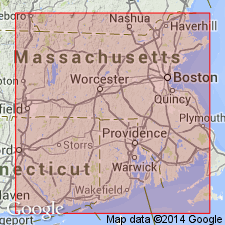
- Usage in publication:
-
- Purgatory Conglomerate
- Modifications:
-
- Revised
- Overview
- Dominant lithology:
-
- Conglomerate
- Quartzite
- Sandstone
- AAPG geologic province:
-
- New England province
Summary:
Author here assigns the Sachuest Arkose, Purgatory Conglomerate, Pondville Conglomerate, Wamsutta Formation, Rhode Island Formation, and Dighton Conglomerate to the Rhode Island Group of northern Rhode Island and southeastern Massachusetts. The Purgatory is similar to the Dighton in composition and authors suggest that the Dighton may actually represent an overthrust of Purgatory Conglomerate. Unit is described as massive and poorly sorted, clasts of cobble to boulder conglomerate of vitreous, bedded to massive quartzite and lesser vein quartz, with interbedded sandstone layers and magnetite-rich sandstone lenses. Unit is approximately 135 m thick.
[Usage of the Rhode Island in this report is not recommended. According to Article 19f of the NACSN code (1983), "In changing the rank of a unit, the same name may not be applied both to the unit as a whole and to a part of it."]
Source: GNU records (USGS DDS-6; Reston GNULEX).
For more information, please contact Nancy Stamm, Geologic Names Committee Secretary.
Asterisk (*) indicates published by U.S. Geological Survey authors.
"No current usage" (†) implies that a name has been abandoned or has fallen into disuse. Former usage and, if known, replacement name given in parentheses ( ).
Slash (/) indicates name conflicts with nomenclatural guidelines (CSN, 1933; ACSN, 1961, 1970; NACSN, 1983, 2005, 2021). May be explained within brackets ([ ]).

